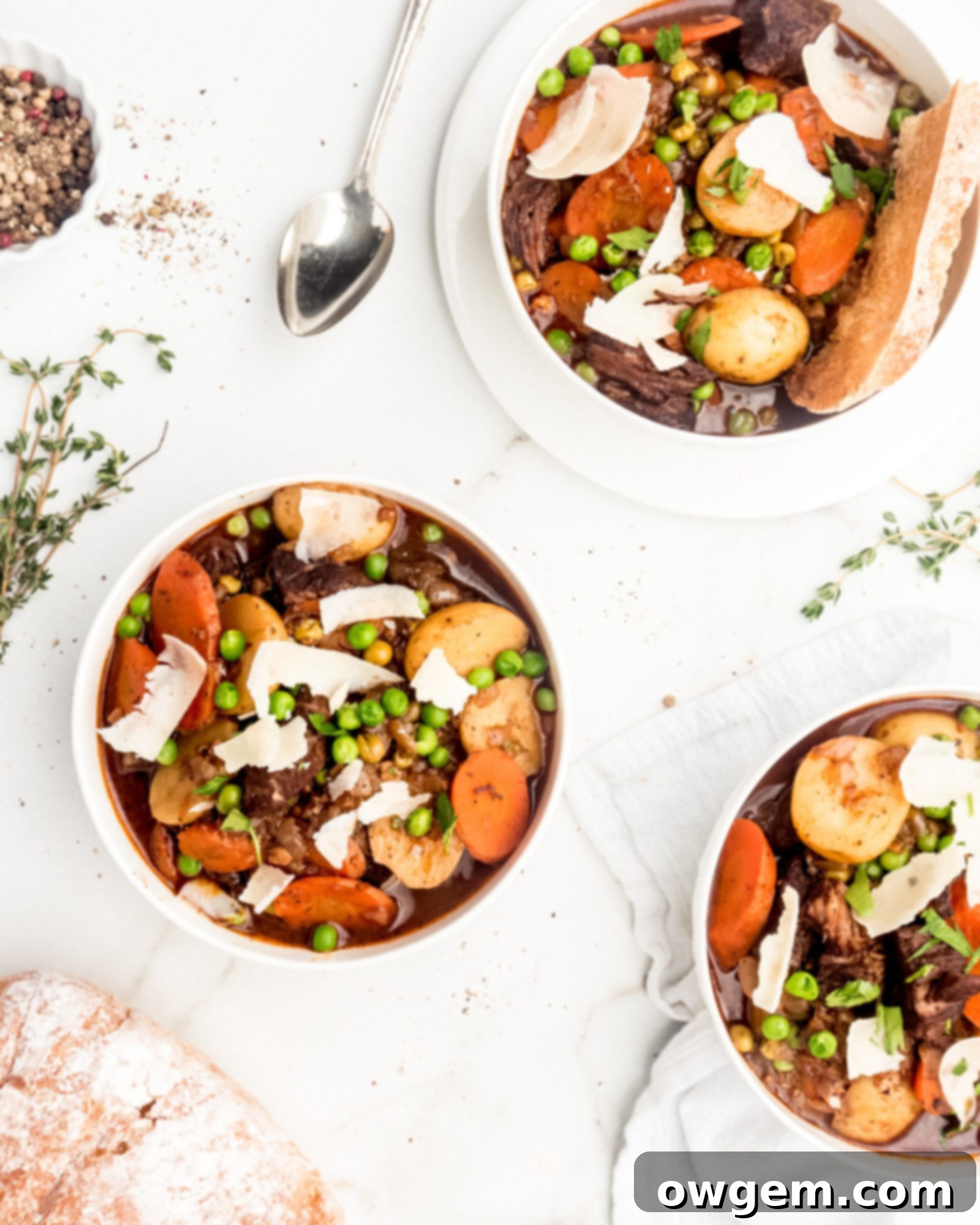Hearty & Flavorful Beef Stew: Your Ultimate Guide to Slow-Cooked Comfort
This super rich and hearty Beef Stew is the quintessential comfort food, perfect for warming you up on a chilly evening or gathering loved ones around the dinner table. Imagine beautifully marbled pieces of beef chuck, slowly braised until they literally melt in your mouth. This exquisite beef is lovingly cooked alongside aromatic red wine, a hint of tangy balsamic vinegar, fragrant thyme, sweet onions, and of course, classic root vegetables like tender carrots, buttery potatoes, and bright green peas. This isn’t just any stew; it’s a thick, chunky masterpiece, brimming with deep, savory flavors that evolve with every spoonful. Serving this magnificent beef stew with a crusty piece of artisanal bread for dipping transforms a simple meal into an unforgettable, heart-warming experience. It’s more than just food; it’s an embrace in a bowl, a testament to the magic of slow cooking, and a dish that truly nourishes both body and soul. Prepare to indulge in a truly satisfying culinary journey that promises rich flavors and unparalleled tenderness.
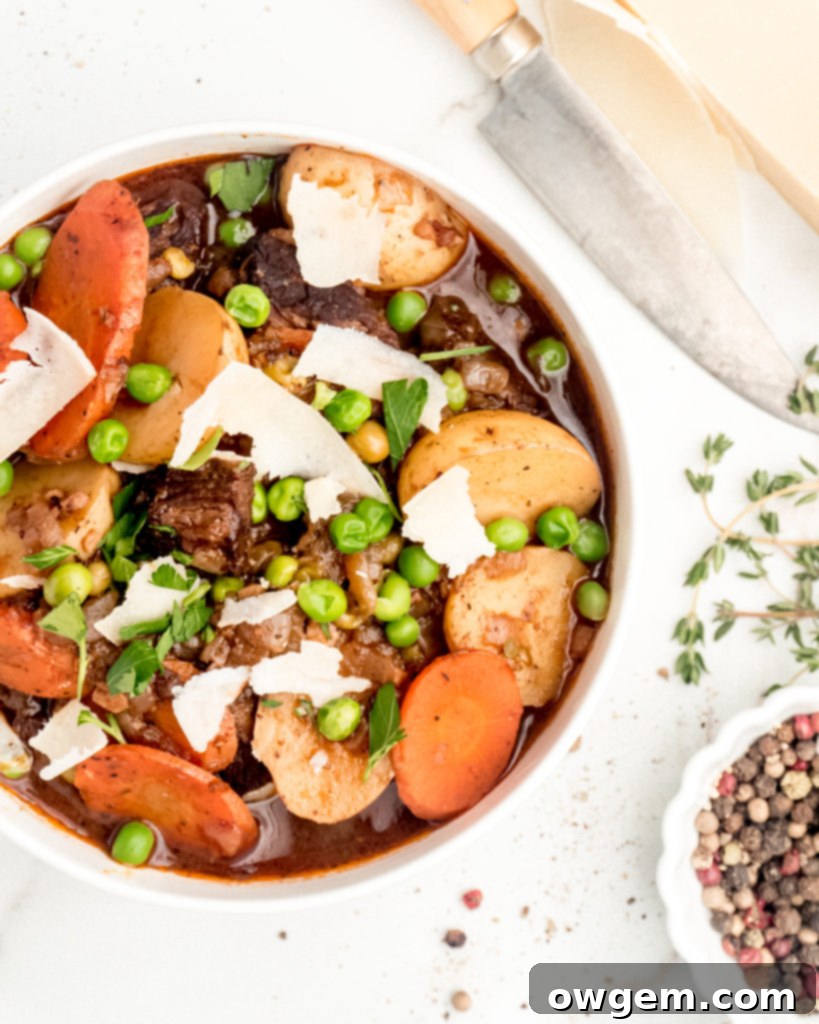
The Art of Braising: Unlocking Unforgettable Tenderness in Beef Stew
The secret to an incredibly tender and deeply flavorful beef stew lies primarily in the cut of beef chosen and the method of cooking: braising. For this recipe, we champion beef chuck roast, a cut renowned for its beautiful marbling and abundant connective tissue. While initially tough, these characteristics are precisely what make it perfect for slow cooking. Braising involves cooking meat slowly in a small amount of liquid in a covered pot, transforming it from tough to irresistibly tender.
During the slow cooking process, the marbled fat within the chuck roast gradually renders, basting the meat in its own juices and infusing it with incredible flavor. More importantly, the high amount of connective tissue – primarily collagen – slowly breaks down. This collagen dissolves into gelatin, a process that happens gradually at low temperatures. The gelatin then melds with the braising liquid, creating a rich, velvety sauce with an unctuous mouthfeel that is simply unmatched. It’s this magical transformation that makes the beef “fall-off-the-bone tender” and gives the stew its characteristic luxurious texture.
However, achieving this exquisite tenderness requires patience and precision. The key is to cook the beef at a relatively low temperature for several hours. If the temperature is too high, the muscle fibers in the beef will contract and toughen, resulting in dry, chewy meat despite the slow cooking time. This is why we consistently recommend braising at a gentle 300°F to 325°F (approximately 150°C to 160°C) for an extended period. This controlled heat allows the collagen ample time to convert to gelatin, ensuring every piece of beef in your stew is succulent, moist, and utterly melt-in-your-mouth delicious. This deliberate approach to braising is what elevates a good beef stew to an exceptional one, making it a true masterpiece of comfort cooking.

Choosing Your Cut: Versatile Beef Options for a Perfect Stew
While beef chuck roast is our top recommendation for its ideal balance of fat and connective tissue, we understand it might not always be readily available or identifiable by that specific name. Fortunately, this versatile cut goes by several aliases, ensuring you can find it at most butchers or grocery stores. Look for labels such as Chuck Eye Roast, Pot Roast, Chuck Roll Roast, or Beef Shoulder/Blade Roast. All these names typically refer to portions of the beef shoulder, which share similar characteristics making them perfect for braising.
Should you still have trouble finding these, excellent alternatives exist that will yield equally delicious results. Top blade roast and bottom chuck roast are fantastic choices, offering great marbling and connective tissue for tender braised beef. Skirt steak, though a thinner cut, can also work beautifully when slow-cooked, breaking down into flavorful, tender strands. Even boneless short ribs, celebrated for their rich marbling and inherent tenderness when braised, can be an exquisite (though often pricier) substitute. The critical factor across all these recommendations is a significant amount of marbling and connective tissue. These elements are vital for developing the deep flavor and achieving that signature melt-in-your-mouth texture that defines a truly exceptional beef stew.
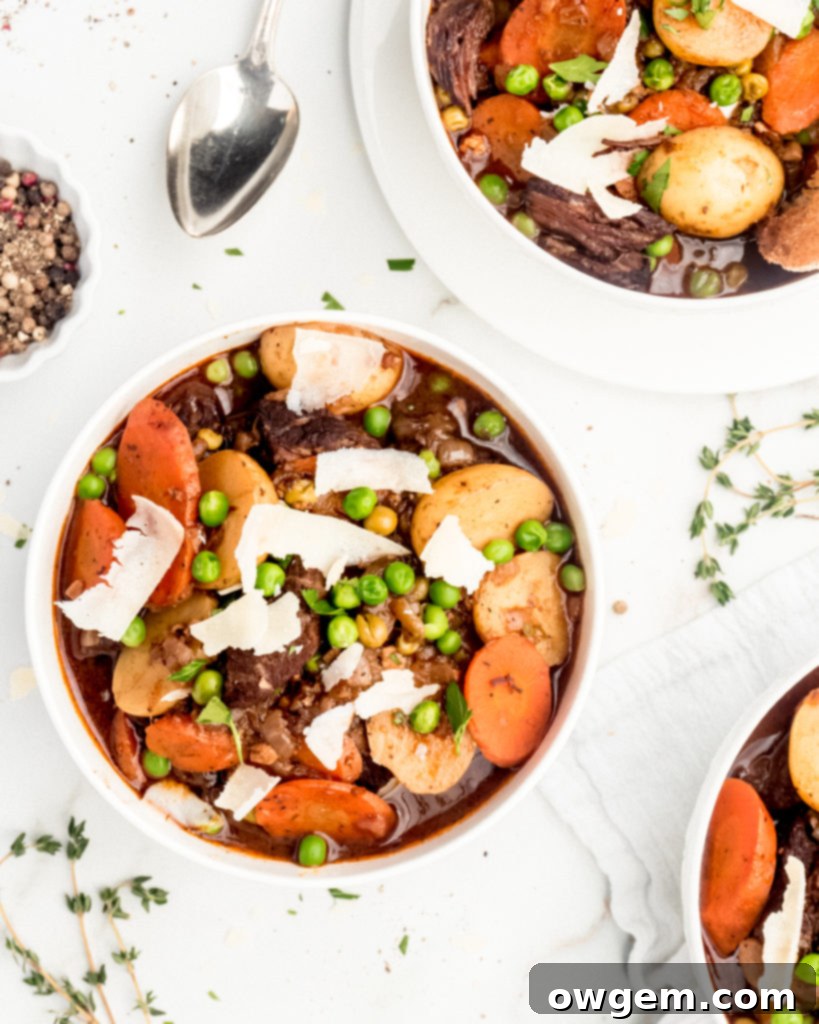
The Magic of Time: Why Your Beef Stew Tastes Even Better the Next Day
While many culinary creations are best enjoyed fresh off the stove, braised dishes, and particularly this beef stew, defy that rule. In fact, most slow-cooked stews reach their peak flavor the day after they’re prepared! This means any leftovers (if you’re lucky enough to have them!) are destined to be even more incredibly delicious. The overnight rest and subsequent reheating process allow several fascinating culinary transformations to occur, intensifying the stew’s already complex flavor profile.
Firstly, as the beef stew sits overnight, the complex carbohydrates present in ingredients like potatoes and carrots continue to break down. This ongoing process releases more natural sugars and starches, leading to a noticeable increase in sweetness and a richer, more integrated vegetable flavor. The textures also soften and blend further, creating a more harmonious consistency throughout the stew.
Secondly, and perhaps most significantly, allowing the stew to rest overnight and then reheating it unleashes a profound boost of umami flavor. This happens because the reheating process further breaks down the proteins in the meat and vegetables. This breakdown liberates a greater concentration of amino acids, particularly glutamates, which are the primary compounds responsible for savory umami taste. The result is a deeper, more robust, and undeniably richer savory essence that permeates every element of the dish.
Thirdly, the aromatic compounds from ingredients like onions, garlic, and thyme have more time to fully infuse into the liquid and solids of the stew. Upon reheating, these aromatic properties are reactivated and dispersed, making the stew incredibly fragrant and enhancing its overall appeal. Essentially, this “mumbo-jumbo” of molecular changes means that your beef stew truly evolves, becoming more flavorful, aromatic, and deeply satisfying with each passing hour. So, if you can resist the temptation to finish it all on day one, you’ll be rewarded with an even more spectacular culinary experience on day two!
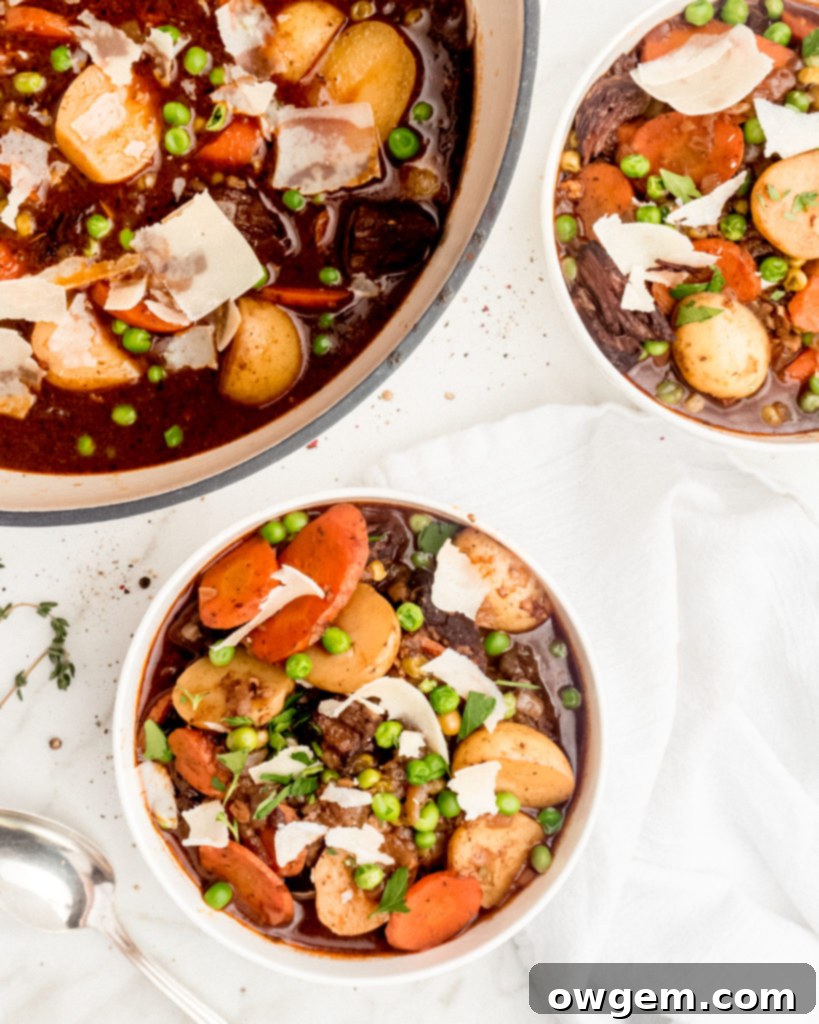
The Umami Secret: Elevating Your Stew with a Parmesan Rind
You might have noticed a rather unconventional ingredient in this recipe: a Parmesan rind. If you’ve never experimented with adding Parmesan rinds to your cooking, prepare for a revelation! This seemingly humble, often discarded part of a Parmesan cheese wheel is a true flavor powerhouse, capable of imparting an incredible boost of savory depth to your dishes.
Parmesan cheese, and particularly its rind, is exceptionally rich in naturally occurring glutamates – the compounds responsible for the fifth basic taste, umami. Umami is that intensely savory, deeply satisfying, and almost meaty flavor that rounds out a dish and makes it feel complete. Adding a Parmesan rind to your braising liquid introduces a concentrated source of this magical flavor, transforming a good stew into an extraordinary one. As the rind simmers slowly in the liquid, it slowly releases its potent umami compounds, infusing the entire stew with a luxurious richness and an indescribable depth that cannot be achieved with just salt and pepper.
As highlighted in many culinary principles, including in recipes like a Greek Salad, the effect of umami is often synergistic: “1+1=8.” When a dish contains multiple umami-rich components, they don’t just add together; they amplify each other’s effects. In this beef stew, the umami from the browned beef, tomato paste, and beef broth already lay a strong foundation. The Parmesan rind acts as a catalyst, elevating and harmonizing all these savory elements, resulting in a beautifully balanced, incredibly rich, and profoundly flavorful stew.
Finding Parmesan rinds is often easier than you might think. Many well-stocked grocery stores carry them (check the specialty cheese section or even ask at the deli counter), and they are a staple at any good cheese market. I often buy them in bulk and store them in my freezer, ready to be dropped into soups, stews, sauces, and stocks whenever a boost of savory goodness is needed. If, however, a Parmesan rind is genuinely out of reach, you can substitute it with about 1/3 cup of freshly shredded Parmigiano Reggiano cheese. While the rind offers a deeper, slower release of flavor, the cheese will still contribute a wonderful savory note. Just remember to remove the softened rind before serving, as it typically doesn’t fully dissolve.
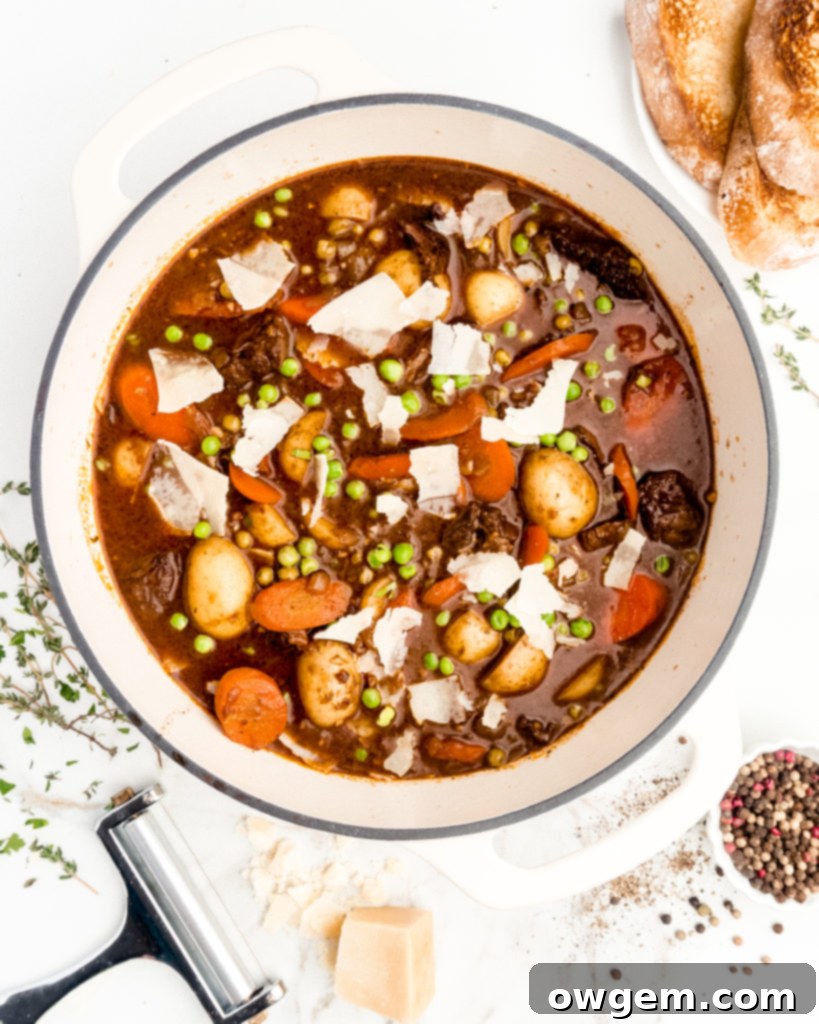
Serving Suggestions and Perfect Pairings for Your Hearty Beef Stew
A truly magnificent beef stew deserves to be served with accompaniments that complement its rich flavors and hearty nature. While the stew is a complete meal in itself, adding a few thoughtful touches can elevate your dining experience even further. The most classic pairing, and one we highly recommend, is a substantial piece of crusty bread. A rustic baguette, a sourdough boule, or even a simple country loaf are ideal for soaking up every last drop of the delectable, gelatin-rich sauce. The contrast of the soft, tender beef and vegetables with the crunchy crust of fresh bread is simply divine.
Beyond bread, consider a light, refreshing side salad with a tangy vinaigrette to cut through the richness of the stew. A simple green salad with mixed greens, a few cherry tomatoes, and a bright lemon-herb dressing would be perfect. For those who enjoy heartier sides, a dollop of creamy mashed potatoes (if not already sufficient potatoes in the stew itself) or a bed of fluffy rice can also provide an excellent foundation for the rich sauce.
To further enhance the culinary experience, selecting the right beverage is key. This red wine-braised beef stew pairs wonderfully with a robust red wine, ideally the same varietal you used in the cooking process. A Cabernet Sauvignon, Merlot, or even a hearty Zinfandel would complement the deep, savory notes of the beef and red wine reduction beautifully. For non-alcoholic options, a sparkling cider or even a richly brewed herbal tea can offer a refreshing counterpoint.
Garnish your finished stew with a sprinkle of fresh parsley or chives just before serving. Not only does this add a pop of color, but the fresh herbs also introduce a bright, herbaceous note that lifts the overall flavor profile. This beef stew is versatile enough for a casual family dinner but also elegant enough for a special occasion, promising warmth, satisfaction, and unforgettable flavor with every serving.
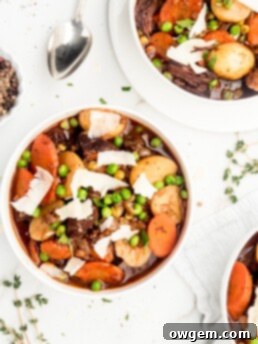
Get the Recipe:
Hearty Beef Stew with Carrots, Peas, and Potatoes
Pin
Rate
Ingredients
- 3 lbs Boneless Beef Chuck Roast, trimmed of any large pieces of fat and cut into 1 ½” pieces
- 2-3 tbsp Vegetable Oil, divided
- 2 Medium Yellow Onions, diced medium
- 10 Garlic Cloves, crushed or minced
- 1 tsp Dried Thyme
- 3 tbsp Balsamic Vinegar
- 2 tbsp Tomato Paste
- 1/4 cup Flour
- 1 Bottle Dry Red Wine
- 4 cups Low Sodium Beef Broth
- 1 Bay Leaf
- 1 ½ tbsp Sugar
- 1 tsp Salt
- 1/2 tsp Freshly Ground Pepper
- 1 Parmesan Rind
- 4 Large Carrots, peeled and sliced into 1” slices
- 1 lb Yellow Baby Potatoes, sliced in half
- 1 cup Frozen Peas
Instructions
-
Preheat oven to 325°F, with the rack in the bottom position. This ensures even cooking from the base.
-
Pat the beef pieces thoroughly dry, which is crucial for achieving a beautiful, deep brown crust, then season them well with salt and freshly ground pepper. Heat a large Dutch oven over medium-high heat. Add 1 tbsp of oil, and carefully place beef pieces in, ensuring not to overcrowd the pot. Browning in batches is key to allow the meat to sear properly, rather than steam. In batches, brown the pieces on each side until a rich crust forms, then remove and place onto a plate. Continue browning in batches until all the beef has been beautifully seared (this typically takes 3-4 batches). Set aside the plate of browned beef with any accumulated juices.
-
Turn the heat down to medium and add the remaining oil if needed, then add the diced onions to the Dutch oven. Sauté until the onions begin to look translucent and slightly softened, about 3 minutes. Stir in the crushed or minced garlic and dried thyme, cooking for an additional minute until fragrant. Then, incorporate the balsamic vinegar and the tomato paste, stirring constantly and cooking for 2 minutes to deepen their flavors. Return the browned beef and its flavorful juices back into the Dutch oven. Sprinkle evenly with the flour, and stir well until combined and the flour fully dissolves, coating the meat and vegetables to help thicken the stew.
-
Carefully pour in the red wine, beef broth, add the bay leaf, sugar, salt, pepper, and the secret ingredient – the Parmesan rind. Stir gently to combine all ingredients. Cover the Dutch oven securely with its lid and place it into the preheated oven. Braise for 2 hours.
-
After the initial 2 hours, carefully remove the Dutch oven from the oven, and add in the peeled and sliced carrots and halved baby potatoes. Gently stir them into the liquid. Return the covered Dutch oven to the oven to braise for 55 more minutes.
-
After 55 minutes, remove the Dutch oven once more. Stir in the frozen peas. The residual heat will cook them perfectly. Return to the oven for an additional 5 minutes. Remove from oven, carefully take out and discard the bay leaf and Parmesan rind (which will have imparted all its delicious flavor), and serve your exquisite beef stew hot.
-
(Optional) If reheating leftovers, place the stew into the oven at 350°F (175°C) until thoroughly hot, stirring occasionally. This method helps maintain texture and flavor better than microwave reheating.
Source: Adapted from Once Upon a Chef
